Electric Power Distribution Automation Systems Market
Electric Power Distribution Automation Systems Market Size and Share Forecast Outlook 2025 to 2035
Electric power distribution automation systems market is projected to grow from USD 29.2 billion in 2025 to USD 58.1 billion by 2035, at a CAGR of 7.1%. Substation Automation will dominate with a 55.9% market share, while industrial will lead the application segment with a 55.9% share.
Electric Power Distribution Automation Systems Market Forecast and Outlook 2025 to 2035
The global electric power distribution automation systems market is projected to reach USD 58.1 billion by 2035, recording an absolute increase of USD 28.9 billion over the forecast period. The market is valued at USD 29.2 billion in 2025 and is set to rise at a CAGR of 7.1% during the assessment period.
The market is expected to grow by nearly 2.0 times during the same period, supported by increasing grid modernization initiatives and growing smart grid deployment worldwide, driving demand for substation automation technologies, feeder automation systems, and advanced distribution management solutions across both developed and emerging utility markets.
Quick Stats for Electric Power Distribution Automation Systems Market
- Electric Power Distribution Automation Systems Market Value (2025): USD 29.2 billion
- Electric Power Distribution Automation Systems Market Forecast Value (2035): USD 58.1 billion
- Electric Power Distribution Automation Systems Market Forecast CAGR: 7.1%
- Leading Implementation Type in Electric Power Distribution Automation Systems Market: Substation Automation (55.9%)
- Key Growth Regions in Electric Power Distribution Automation Systems Market: North America, Asia Pacific, and Europe
- Top Players in Electric Power Distribution Automation Systems Market: MYR Group Inc., THE KANSAI ELECTRIC POWER CO. INC., Hitachi Energy Ltd., Siemens, General Electric Company, Cisco Systems Inc., Schneider Electric, ABB, Eaton, Power Grid Corporation of India Limited
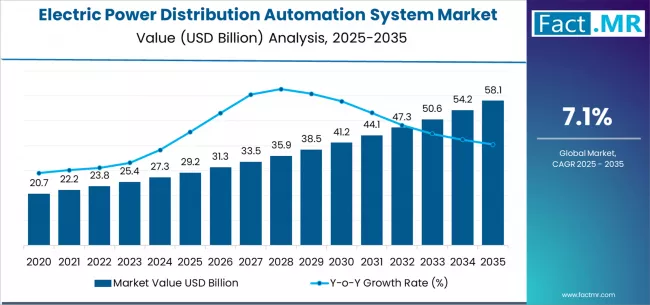
Growing application diversity in renewable energy integration, distributed generation management, and demand response programs creates expanding opportunities for intelligent electronic device implementations and specialized communication network innovations. Rising infrastructure investments in Asia Pacific nations, coupled with expanding utility automation capabilities through smart meter deployments and grid digitalization programs, further accelerate market penetration across diverse electricity distribution segments.
The growing global emphasis on grid reliability and power quality improvement, particularly in industrial manufacturing and commercial operations, generates sustained demand for automated fault detection alternatives and self-healing grid technologies incorporating advanced sensors and communication systems.
Utility research demonstrating measurable improvements in outage duration reduction exceeding 40%, enhanced operational efficiency, and preventive maintenance optimization reinforces distribution company confidence in automation system adoption, while renewable energy trends toward decentralized generation expand addressable market opportunities beyond traditional centralized grid control into distributed energy resource management categories.
Electric utilities and industrial facilities increasingly incorporate distribution automation into grid operation centers, substation facilities, and feeder networks, creating mainstream adoption channels that extend beyond basic supervisory control into sophisticated autonomous grid management environments.
However, high capital investment requirements for legacy system replacement and cybersecurity concerns affecting critical infrastructure protection may pose challenges to market expansion. Technical complexity in system integration and interoperability requirements across multi-vendor environments also influence deployment decisions, requiring utilities to develop comprehensive modernization strategies catering to specific grid topology and operational requirements across different geographical markets.
Regulatory uncertainty during utility rate case proceedings and technical requirements for communication network deployment and data management may limit adoption rates among smaller distribution utilities in developing regions with constrained capital budgets for advanced automation infrastructure and cybersecurity protocols.
Electric Power Distribution Automation Systems Market Year-over-Year Forecast 2025 to 2035
Between 2025 and 2030, the electric power distribution automation systems market is projected to expand from USD 29.2 billion to USD 41.2 billion, resulting in a value increase of USD 12.0 billion, which represents 41.5% of the total forecast growth for the decade. This phase of development will be shaped by rising demand for grid reliability enhancement and renewable energy integration, infrastructure expansion in substation automation deployments and intelligent feeder switching systems, as well as expanding integration with advanced metering infrastructure and distribution management platforms. Companies are establishing competitive positions through investment in intelligent electronic device technology development, comprehensive SCADA system capabilities, and strategic market expansion across investor-owned utility networks, municipal utility segments, and industrial microgrid applications.
From 2030 to 2035, the market is forecast to grow from USD 41.2 billion to USD 58.1 billion, adding another USD 16.9 billion, which constitutes 58.5% of the overall ten-year expansion. This period is expected to be characterized by the expansion of specialized automation derivatives, including artificial intelligence-based grid optimization and edge computing implementations tailored for specific distribution network architectures, strategic collaborations between automation vendors and utility companies, and an enhanced focus on cybersecurity hardening and resilience enhancement. The growing emphasis on distributed energy resource orchestration and electric vehicle integration will drive demand for advanced distribution automation solutions across diverse utility applications.
Electric Power Distribution Automation Systems Market Key Takeaways
| Metric | Value |
|---|---|
| Market Value (2025) | USD 29.2 billion |
| Market Forecast Value (2035) | USD 58.1 billion |
| Forecast CAGR (2025-2035) | 7.1% |
Why Does Grid Modernization Drive Electric Power Distribution Automation Systems Market Growth?
The electric power distribution automation systems market grows by enabling electric utilities, grid operators, and industrial facilities to access intelligent automation technologies that support operational reliability while meeting regulatory demand for improved service quality and grid resilience. Distribution utilities face mounting pressure to reduce outage duration and frequency metrics with proven automation solutions, with distribution automation systems typically providing 30-50% reduction in customer interruption duration making these technologies essential for competitive utility performance and regulatory compliance. The electricity distribution industry's need for real-time visibility and remote control capabilities creates demand for various automation technologies that can provide rapid fault isolation, maintain system stability across distributed generation integration, and ensure operational efficiency without compromising grid security or reliability standards.
Government initiatives promoting smart grid investment and infrastructure modernization drive adoption in distribution substations, feeder circuits, and consumer connection points, where automation deployment has a direct impact on power quality and service restoration outcomes. The utility industry's growing focus on operational cost reduction and asset utilization optimization further expands market opportunities, with operational data demonstrating measurable efficiency improvements through automated switching operations, predictive maintenance scheduling, and voltage optimization programs. However, capital budget constraints affecting utility investment cycles and technical requirements for communication network infrastructure may limit accessibility among smaller municipal utilities and rural electric cooperatives in developing regions with limited financial resources for comprehensive distribution automation systems and advanced metering deployment.
Segmental Analysis
The market is segmented by implementation, application, and region. By implementation, the market is divided into substation automation, feeder automation, and consumer side automation.
Based on application, the market is categorized into industrial, commercial, and residential. Regionally, the market spans North America, Asia Pacific, Europe, Latin America, and mea.
What Makes Substation Automation the Dominant Implementation Segment?
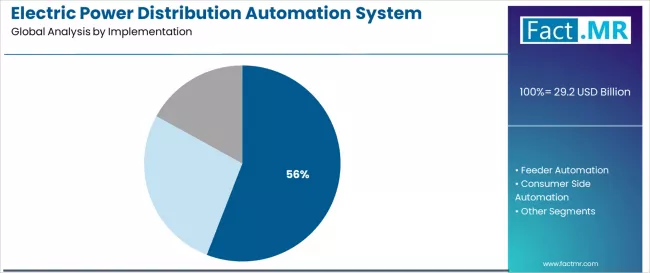
The substation automation segment represents the dominant force in the electric power distribution automation systems market, capturing approximately 55.9% of total market share in 2025. This category encompasses solutions featuring comprehensive substation control and monitoring capabilities from intelligent electronic devices and substation SCADA systems, including protection relay coordination and transformer monitoring that enable superior operational visibility and consistent reliability standards across all distribution substation applications.
The substation automation segment's market leadership stems from its critical infrastructure role, with automation systems capable of meeting diverse voltage level requirements while maintaining high reliability and operational control across all utility environments. The substation automation technology's widespread adoption for primary distribution control, voltage regulation, and power quality management drives sustained market dominance across global utility infrastructure modernization programs.
The feeder automation segment maintains a substantial 31.0% market share, serving utilities requiring automated fault detection and isolation capabilities through recloser controls and automated switching systems. These technologies offer rapid service restoration for distribution circuits and reduced outage exposure while providing sufficient functionality to meet fault location requirements and load transfer protocols.
The consumer side automation segment accounts for approximately 13.1% of the market, serving advanced metering infrastructure, demand response systems, and distributed energy resource management applications requiring two-way communication and consumer engagement.
Key advantages driving the substation automation segment include:
- Comprehensive monitoring infrastructure with integrated protection and control systems that ensure reliable substation operation and equipment asset management
- Advanced functionality capabilities allowing centralized coordination of distributed substation assets without requiring extensive manual intervention
- Proven reliability delivering consistent operational performance while maintaining compact equipment footprint for space-constrained substation facilities
- Broad utility acceptance enabling straightforward integration with existing transmission interfaces and proven operational benefits across diverse grid topologies
How does Industrial Application Lead Market Adoption?
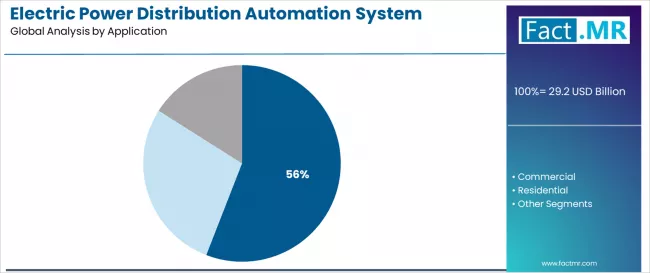
Industrial application dominates the electric power distribution automation systems market with a 55.9% market share in 2025, reflecting the critical role of reliable electricity supply in supporting manufacturing operations and continuous process industries worldwide.
The industrial segment's market leadership is reinforced by stringent power quality requirements, high economic impact of service interruptions, and rising demand for captive power management systems across automotive manufacturing, semiconductor fabrication, and chemical processing facilities in developed and emerging industrial economies.
The segment benefits from private microgrid development requiring sophisticated automation control, industrial park utility networks demanding enhanced reliability, and manufacturing facility modernization incorporating distributed generation.
The commercial segment represents a significant application category, capturing 26.7% market share through office buildings, data centers, and retail facilities requiring reliable electricity service and power quality management.
This segment benefits from growing adoption of building automation integration with utility systems, distributed solar photovoltaic installations requiring grid interconnection management, and commercial facility operations demanding demand charge optimization.
The residential segment accounts for 17.4% market share through smart home integration, residential solar systems, and advanced metering infrastructure supporting time-of-use pricing and demand response programs.
Key market dynamics supporting application segment growth include:
- Industrial sector expansion driven by manufacturing facility development and production automation, requiring reliable electricity distribution infrastructure in emerging industrial zones
- Commercial building modernization trends require advanced power management and distributed energy resource integration capabilities
- Integration of electric vehicle charging infrastructure enabling comprehensive load management and grid services
- Growing emphasis on application-specific reliability driving demand for customized automation solutions
What are the Drivers, Restraints, and Key Trends of the Electric Power Distribution Automation Systems Market?
The market is driven by three concrete demand factors tied to infrastructure aging and renewable integration. First, increasing electricity infrastructure replacement needs globally create growing demand for modern distribution automation systems, with aging grid assets requiring replacement across developed markets while infrastructure build-out accelerates in emerging economies requiring comprehensive automation infrastructure. Second, renewable energy integration challenges and distributed generation proliferation drive increased adoption of advanced distribution management systems, with solar and wind capacity additions requiring sophisticated voltage control and power flow management by 2030. Third, technological advancements in edge computing and artificial intelligence enable more effective grid optimization that reduces operational costs while improving reliability metrics and asset utilization across diverse distribution network configurations.
Market restraints include high capital investment requirements for comprehensive automation deployment that can exceed utility capital budget allocations, particularly during economic downturns where infrastructure spending faces constraints. Cybersecurity vulnerability concerns and critical infrastructure protection requirements pose another significant challenge, as distribution automation systems require extensive security protocols and threat monitoring, potentially causing increased operational costs and system complexity. Interoperability challenges across multi-vendor environments create additional deployment barriers for system integration, demanding ongoing investment in communication protocol standardization and data model harmonization programs.
Key trends indicate accelerated deployment in Asia Pacific utility networks, particularly India and China, where grid capacity expansion and urbanization drive comprehensive distribution automation adoption. Technology integration trends toward cloud-based analytics platforms with machine learning-enabled fault prediction, blockchain applications for distributed energy resource transactions, and 5G communication networks enable advanced operational capabilities that optimize grid performance and enable new utility business models. However, the market thesis could face disruption if significant advances in centralized battery storage or major regulatory changes reduce the economic justification for distributed automation investments across utility service territories.
Analysis of the Electric Power Distribution Automation Systems Market by Key Countries
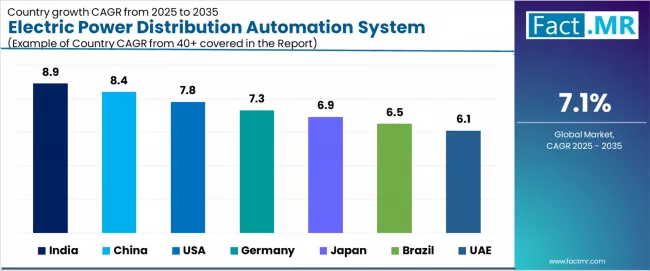
| Country | CAGR (2025 to 2035) |
|---|---|
| India | 8.9% |
| China | 8.4% |
| usa | 7.8% |
| Germany | 7.3% |
| Japan | 6.9% |
| Brazil | 6.5% |
| UAE | 6.1% |
The electric power distribution automation systems market is expanding rapidly, with India leading at an 8.9% CAGR through 2035, driven by smart grid rollout and utility automation initiatives supporting infrastructure modernization. China follows at 8.4%, supported by massive grid modernization investments and comprehensive distribution network upgrades. USA posts 7.8%, anchored by aging infrastructure replacement and grid resilience enhancement programs.
Germany records 7.3%, reflecting renewable energy integration requirements and smart meter deployment. Japan grows at 6.9%, with grid digitalization programs and disaster resilience initiatives. Brazil advances at 6.5%, emphasizing distribution network expansion and operational efficiency improvement, while UAE grows steadily at 6.1%, focusing on smart city infrastructure and grid resilience upgrades.
India Leads Global Market Expansion
India demonstrates the strongest growth potential in the electric power distribution automation systems market with a CAGR of 8.9% through 2035. The country's leadership position stems from smart grid rollout programs, comprehensive utility automation initiatives, and government-supported infrastructure modernization enabling mainstream distribution automation adoption. Growth is concentrated in major utility service territories, including state electricity boards in Maharashtra, Gujarat, Tamil Nadu, and Karnataka, where distribution companies are implementing large-scale automation deployments for operational improvement.
Infrastructure development through central government schemes, state utility modernization programs, and private sector investments expands deployment across urban distribution networks, rural electrification projects, and industrial corridor developments. The country's growing electricity sector provides policy support for distribution automation, including smart grid mission implementation and operational efficiency mandates.
Key market factors:
- Investment concentrated in state utility modernization programs and metropolitan distribution networks with comprehensive automation requirements
- Policy support through government schemes and regulatory mandates for service quality improvement
- Comprehensive utility ecosystem, including established equipment suppliers with proven domestic manufacturing capabilities
- Technology integration featuring SCADA systems, intelligent electronic devices, and communication network technologies
China Emerges as High-Growth Market
In eastern coastal provinces, northern industrial regions, and southern metropolitan areas, the adoption of distribution automation is accelerating across state grid corporation networks and urban distribution systems, driven by grid modernization mandates and renewable integration requirements. The market demonstrates strong growth momentum with a CAGR of 8.4% through 2035, linked to massive grid modernization investments, comprehensive distribution network upgrades, and national smart grid development programs.
Chinese utilities are implementing advanced automation systems across distribution substations and feeder networks to enhance operational efficiency while meeting growing demand in expanding urbanization and industrial electricity consumption sectors. The country's grid modernization strategy creates persistent demand for intelligent distribution equipment, while increasing emphasis on renewable energy accommodation drives adoption of advanced voltage control and distributed generation management technologies.
Key development areas:
- State grid operations and urban utility networks leading automation deployment with comprehensive modernization programs
- Domestic manufacturing capacity providing integrated equipment supply with substantial production scale
- Strategic initiatives between grid corporations and technology suppliers are expanding innovation development
- Integration of artificial intelligence systems and comprehensive digital twin platforms
usa Shows Strong Regional Leadership
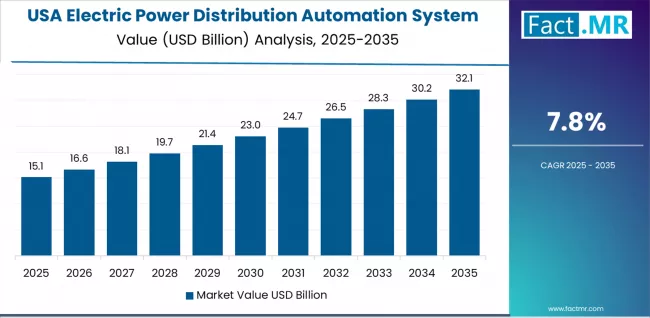
The USA's market expansion is driven by aging infrastructure replacement needs and grid resilience enhancement across investor-owned utilities and municipal systems. The country demonstrates promising growth potential with a CAGR of 7.8% through 2035, supported by replacement of aging infrastructure, grid resilience enhancement programs following major storm events, and regulatory support for utility grid modernization investments.
American utilities face implementation challenges related to capital cost recovery, requiring prudent investment strategies and support from public utility commission rate case approvals and federal infrastructure funding. However, substantial infrastructure replacement needs and reliability improvement imperatives create compelling drivers for distribution automation deployment, particularly in regions where aging equipment and service quality metrics have direct impact on regulatory performance reviews.
Market characteristics:
- Investor-owned utilities and large municipal systems showing robust automation investment with established modernization roadmaps
- Regional concentration focused on storm-prone coastal areas and aging infrastructure in Northeastern and Midwestern states
- Future projections indicate continued grid hardening emphasis with climate resilience priorities
- Growing focus on distributed energy resource management and electric vehicle integration capabilities
Germany Demonstrates Technology Innovation
The German market leads in renewable integration automation based on advanced distribution management systems and virtual power plant coordination for enhanced grid stability. The country shows strong potential with a CAGR of 7.3% through 2035, driven by renewable energy integration requirements, smart meter deployment mandates, and comprehensive distribution network digitalization in major utility service areas.
German distribution operators are implementing evidence-based automation strategies for renewable accommodation and voltage management, particularly in regions with high distributed solar penetration and specialized requirements demanding sophisticated grid control capabilities. Technology deployment channels through established equipment manufacturers and utility engineering departments expand coverage across regional distribution networks and municipal utility systems.
Leading market segments:
- Distribution network operators implementing advanced automation with comprehensive renewable integration programs
- Technology partnerships with equipment manufacturers, achieving innovative grid management solution development
- Strategic collaborations between German utilities and research institutions are expanding pilot program deployment
- Focus on interoperability standards and cybersecurity requirements
Japan Emphasizes Innovation and Disaster Resilience
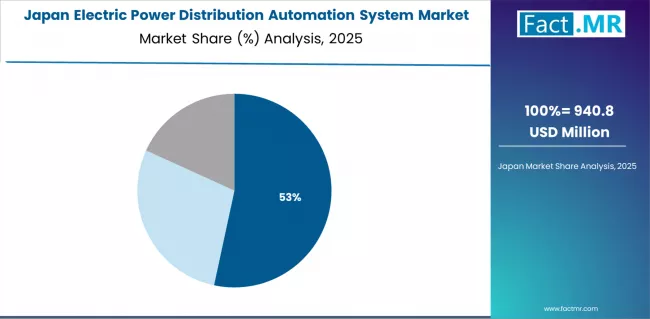
Japan's electric power distribution automation systems market demonstrates sophisticated grid management landscape, characterized by comprehensive integration of automation technologies with existing utility operations across regional electric power companies and advanced distribution networks. The country shows steady growth momentum with a CAGR of 6.9% through 2035, driven by grid digitalization programs and disaster resilience enhancement initiatives following major earthquake experiences.
Japan's emphasis on grid reliability and rapid restoration capabilities creates requirements for advanced automation systems that support comprehensive outage management and emergency response protocols. The market benefits from established relationships between domestic equipment manufacturers and regional utilities, creating comprehensive technology ecosystems that prioritize system reliability and operational excellence. Utility networks in major metropolitan regions showcase advanced automation implementations where distribution systems achieve exceptional reliability through integrated monitoring programs.
Key market characteristics:
- Regional electric power companies driving comprehensive automation deployment with emphasis on disaster preparedness and rapid restoration
- Technology partnerships enabling advanced system integration with proven operational capabilities
- Collaboration between Japanese utilities and equipment manufacturers is expanding innovation development
- Emphasis on seismic resilience and emergency response optimization methodologies
Brazil Emphasizes Innovation and Infrastructure Expansion
Brazil's electric power distribution automation systems market demonstrates evolving utility landscape focused on distribution network expansion and operational efficiency improvement, with documented adoption of automation technologies supporting service quality enhancement across concessionaire territories.
The country maintains growth momentum with a CAGR of 6.5% through 2035, driven by distribution network expansion, operational efficiency improvement mandates through regulatory quality indicators, and comprehensive utility modernization aligned with regulatory compliance goals.
Major utility concessionaires in São Paulo, Rio de Janeiro, Minas Gerais, and Southern states showcase advancing automation deployment where distribution companies integrate with existing infrastructure and comprehensive service quality programs.
Key market characteristics:
- Distribution concessionaires driving automation investment with emphasis on regulatory compliance and service quality indicators
- Public-private partnerships enabling infrastructure investment with comprehensive modernization programs
- Technology collaboration between Brazilian utilities and international equipment suppliers is expanding market capabilities
- Emphasis on non-technical loss reduction and operational efficiency methodologies
UAE Emphasizes Innovation and Smart City Development
The UAE's electric power distribution automation systems market demonstrates strategic infrastructure development landscape, characterized by smart city integration initiatives and grid modernization programs aligned with national economic diversification strategies. The country shows steady growth momentum with a CAGR of 6.1% through 2035, driven by smart city infrastructure development and grid resilience enhancement programs in major emirates including Dubai, Abu Dhabi, and Sharjah.
The UAE's emphasis on world-class utility service and infrastructure excellence creates requirements for advanced distribution automation that supports reliability targets and smart grid functionality. The market benefits from substantial infrastructure investment capacity, creating comprehensive deployment programs that prioritize technological leadership and operational innovation. Utility networks in major development zones showcase advancing automation implementations where distribution systems target international benchmark performance through integrated technology programs.
Key market characteristics:
- Federal and emirate-level utilities driving advanced automation deployment with emphasis on smart city integration and service excellence
- Technology partnerships enabling international best practice implementation with comprehensive innovation programs
- Strategic collaboration between UAE utilities and global technology providers is expanding market capabilities
- Emphasis on grid digitalization and customer engagement methodologies
Europe Market Split by Country
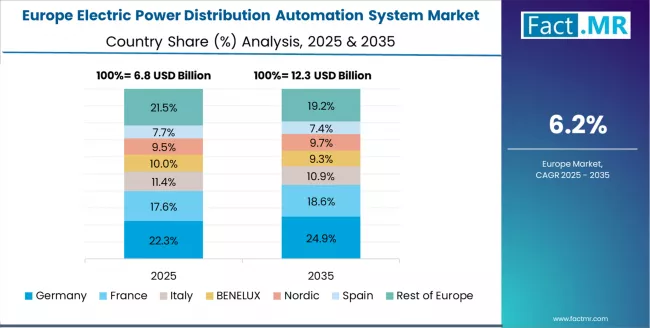
The electric power distribution automation systems market in Europe is projected to grow from USD 6.7 billion in 2025 to USD 13.0 billion by 2035, registering a CAGR of 6.9% over the forecast period. Germany is expected to maintain its leadership position with a 28.4% market share in 2025, supported by its comprehensive renewable energy integration requirements, extensive distribution network infrastructure, and strong regulatory framework for smart grid deployment across major utility service territories.
France follows with a 23.6% share in 2025, driven by national smart meter rollout programs implementing advanced metering infrastructure and distribution automation integration. The UK holds a 19.8% share through comprehensive distribution network price control mechanisms incentivizing innovation and reliability improvement. Italy commands a 14.7% share, while Spain accounts for 8.9% in 2025.
The rest of Europe region maintains a 4.6% collective share, attributed to increasing distribution automation adoption in Nordic utility networks and emerging Eastern European grid modernization implementing infrastructure upgrade programs. By 2035, Germany is projected to hold 28.1% share, France 23.9%, UK 20.0%, Italy 14.9%, Spain 9.0%, and Rest of Europe 4.1%, reflecting sustained growth momentum across all major European electricity distribution markets.
Competitive Landscape of the Electric Power Distribution Automation Systems Market
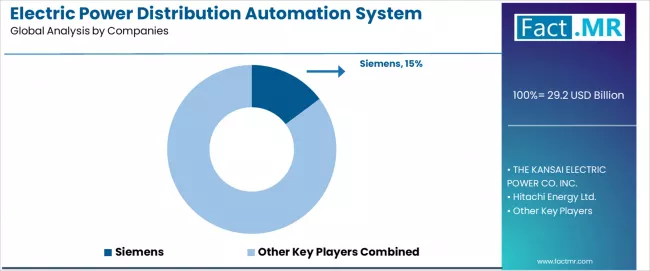
The electric power distribution automation systems market features approximately 20-30 meaningful players with moderate to high concentration, where the top three companies control roughly 35-45% of global market share through established technology portfolios and extensive utility customer relationships. Competition centers on system integration capability, cybersecurity features, and operational reliability rather than equipment price alone.
Market leaders include Siemens, ABB, and Schneider Electric, which maintain competitive advantages through comprehensive distribution automation solution portfolios, global service networks, and deep expertise in the power systems engineering and utility automation sectors, creating high brand loyalty among electric utilities.
These companies leverage established utility relationships and ongoing technology innovation to defend market positions while expanding into adjacent distributed energy resource management and grid edge intelligence applications. Siemens commands approximately 14.8% market share through strategic technology leadership and comprehensive solution portfolio excellence.
Challengers encompass General Electric Company and Hitachi Energy Ltd., which compete through established power equipment portfolios and strong regional presence in key utility markets. Technology specialists, including Cisco Systems Inc., Eaton, and Power Grid Corporation of India Limited, focus on specific system components or geographic markets, offering differentiated capabilities in communication networks, protection equipment, and regional utility services.
Utility companies including THE KANSAI ELECTRIC POWER CO. INC. and engineering firms like MYR Group Inc. participate through system integration services and deployment capabilities, particularly in high-growth markets including India and China, where local presence provides advantages in utility relationship management and regulatory navigation.
Market dynamics favor companies that combine advanced automation technologies with comprehensive system integration capabilities that address the complete deployment lifecycle from design through commissioning and long-term maintenance support. Strategic partnerships between equipment manufacturers and utilities accelerate technology adoption cycles, while cybersecurity expertise initiatives enable critical infrastructure protection and regulatory compliance across utility operations.
Global Electric Power Distribution Automation Systems Market - Stakeholder Contribution Framework
Electric power distribution automation systems represent critical infrastructure that enables electric utilities, grid operators, and industrial facilities to achieve operational reliability and service quality without manual intervention, typically providing 40-60% reduction in outage duration while enabling real-time grid visibility and control. With the market projected to grow from USD 29.2 billion in 2025 to USD 58.1 billion by 2035 at a 7.1% CAGR, these automation systems offer compelling advantages - proven reliability improvement, operational efficiency gains, and advanced grid management capabilities - making them essential for utility grid modernization (major application), industrial power systems (critical segment), and diverse electricity distribution operations seeking enhanced automation solutions. Scaling deployment rates and system capabilities requires coordinated action across utility policy, technical standards, equipment manufacturers, system integrators, and regulatory agencies.
How Governments Could Spur Local Deployment and Innovation?
- Grid Modernization Programs: Include distribution automation in national infrastructure initiatives, providing targeted funding for substation automation in utility service territories and supporting distribution companies through cost recovery mechanisms and performance incentives.
- Regulatory Framework Enhancement: Implement favorable rate treatment for automation investments, provide regulatory incentives for reliability improvement and operational efficiency, and establish supportive frameworks that encourage comprehensive grid modernization over minimal compliance approaches.
- Standardization & Interoperability: Create harmonized technical standards for distribution automation systems across utility applications, establish clear cybersecurity requirements for critical infrastructure, and develop international coordination protocols that facilitate technology deployment and vendor competition.
- Workforce Development Initiatives: Fund training programs for utility engineers, system operators, and field technicians. Invest in educational initiatives that bridge power systems fundamentals with practical automation system operation and cybersecurity management capabilities.
How Industry Bodies Could Support Market Development?
- Technical Standards & Guidelines: Define standardized communication protocols for distribution automation across substations, feeders, and consumer systems, establish universal testing procedures for interoperability verification, and create certification programs for system performance that utilities can specify.
- Best Practices Development: Lead knowledge sharing initiatives that demonstrate automation deployment advantages, emphasizing proven reliability improvements, cost-benefit analyses, and operational efficiency gains compared to traditional manual operations.
- Cybersecurity Frameworks: Develop comprehensive security guidelines for distribution automation, establish threat assessment methodologies, and create incident response protocols, ensuring consistent protection across different utility environments and vendor implementations.
How Manufacturers and System Integrators Could Strengthen the Ecosystem?
- Advanced Technology Development: Develop next-generation automation platforms with enhanced artificial intelligence capabilities, improved edge computing performance, and integrated cybersecurity features that optimize grid operations while reducing deployment complexity.
- Comprehensive Integration Services: Provide end-to-end deployment support that encompasses system design, equipment commissioning, operator training, and ongoing maintenance optimization, enabling utilities to maximize automation benefits and reliability improvement throughout system lifecycle.
- Partnership Networks: Offer flexible collaboration arrangements for electric utilities and industrial customers, including technology roadmap consulting, phased deployment options, and performance guarantee programs that keep automation systems aligned with evolving grid requirements and regulatory mandates.
Key Players in the Electric Power Distribution Automation Systems Market
- MYR Group Inc.
- THE KANSAI ELECTRIC POWER CO. INC.
- Hitachi Energy Ltd.
- Siemens
- General Electric Company
- Cisco Systems Inc.
- Schneider Electric
- ABB
- Eaton
- Power Grid Corporation of India Limited
Scope of the Report
| Items | Values |
|---|---|
| Quantitative Units | USD 29.2 Billion |
| Implementation | Substation Automation, Feeder Automation, Consumer Side Automation |
| Application | Industrial, Commercial, Residential |
| Regions Covered | North America, Asia Pacific, Europe, Latin America, mea |
| Country Covered | India, China, USA, Germany, Japan, Brazil, UAE, and 40+ countries |
| Key Companies Profiled | MYR Group Inc., THE KANSAI ELECTRIC POWER CO. INC., Hitachi Energy Ltd., Siemens, General Electric Company, Cisco Systems Inc., Schneider Electric, ABB, Eaton, Power Grid Corporation of India Limited |
| Additional Attributes | Dollar sales by implementation and application categories, regional deployment trends across North America, Asia Pacific, and Europe, competitive landscape with automation equipment manufacturers and system integrators, technical specifications and interoperability requirements, integration with utility SCADA systems and advanced metering infrastructure. |
Electric Power Distribution Automation Systems Market by Segments
-
Implementation :
- Substation Automation
- Feeder Automation
- Consumer Side Automation
-
Application :
- Industrial
- Commercial
- Residential
-
Region :
- North America
- usa
- Canada
- Mexico
- Europe
- Germany
- France
- UK
- Italy
- Spain
- Rest of Europe
- Asia Pacific
- China
- India
- Japan
- South Korea
- Australia & New Zealand
- ASEAN
- Rest of Asia Pacific
- Latin America
- Brazil
- Argentina
- Rest of Latin America
- mea
- Kingdom of Saudi Arabia
- Other GCC Countries
- Turkey
- South Africa
- Rest of mea
- North America
Table of Content
- Executive Summary
- Global Market Outlook
- Demand to side Trends
- Supply to side Trends
- Technology Roadmap Analysis
- Analysis and Recommendations
- Market Overview
- Market Coverage / Taxonomy
- Market Definition / Scope / Limitations
- Market Background
- Market Dynamics
- Drivers
- Restraints
- Opportunity
- Trends
- Scenario Forecast
- Demand in Optimistic Scenario
- Demand in Likely Scenario
- Demand in Conservative Scenario
- Opportunity Map Analysis
- Product Life Cycle Analysis
- Supply Chain Analysis
- Investment Feasibility Matrix
- Value Chain Analysis
- PESTLE and Porter’s Analysis
- Regulatory Landscape
- Regional Parent Market Outlook
- Production and Consumption Statistics
- Import and Export Statistics
- Market Dynamics
- Global Market Analysis 2020 to 2024 and Forecast, 2025 to 2035
- Historical Market Size Value (USD Million) Analysis, 2020 to 2024
- Current and Future Market Size Value (USD Million) Projections, 2025 to 2035
- Y to o to Y Growth Trend Analysis
- Absolute $ Opportunity Analysis
- Global Market Pricing Analysis 2020 to 2024 and Forecast 2025 to 2035
- Global Market Analysis 2020 to 2024 and Forecast 2025 to 2035, By Implementation
- Introduction / Key Findings
- Historical Market Size Value (USD Million) Analysis By Implementation, 2020 to 2024
- Current and Future Market Size Value (USD Million) Analysis and Forecast By Implementation, 2025 to 2035
- Substation Automation
- Feeder Automation
- Consumer Side Automation
- Y to o to Y Growth Trend Analysis By Implementation, 2020 to 2024
- Absolute $ Opportunity Analysis By Implementation, 2025 to 2035
- Global Market Analysis 2020 to 2024 and Forecast 2025 to 2035, By Application
- Introduction / Key Findings
- Historical Market Size Value (USD Million) Analysis By Application, 2020 to 2024
- Current and Future Market Size Value (USD Million) Analysis and Forecast By Application, 2025 to 2035
- Industrial
- Commercial
- Residential
- Y to o to Y Growth Trend Analysis By Application, 2020 to 2024
- Absolute $ Opportunity Analysis By Application, 2025 to 2035
- Global Market Analysis 2020 to 2024 and Forecast 2025 to 2035, By Region
- Introduction
- Historical Market Size Value (USD Million) Analysis By Region, 2020 to 2024
- Current Market Size Value (USD Million) Analysis and Forecast By Region, 2025 to 2035
- North America
- Latin America
- Western Europe
- Eastern Europe
- East Asia
- South Asia and Pacific
- Middle East & Africa
- Market Attractiveness Analysis By Region
- North America Market Analysis 2020 to 2024 and Forecast 2025 to 2035, By Country
- Historical Market Size Value (USD Million) Trend Analysis By Market Taxonomy, 2020 to 2024
- Market Size Value (USD Million) Forecast By Market Taxonomy, 2025 to 2035
- By Country
- USA
- Canada
- Mexico
- By Implementation
- By Application
- By Country
- Market Attractiveness Analysis
- By Country
- By Implementation
- By Application
- Key Takeaways
- Latin America Market Analysis 2020 to 2024 and Forecast 2025 to 2035, By Country
- Historical Market Size Value (USD Million) Trend Analysis By Market Taxonomy, 2020 to 2024
- Market Size Value (USD Million) Forecast By Market Taxonomy, 2025 to 2035
- By Country
- Brazil
- Chile
- Rest of Latin America
- By Implementation
- By Application
- By Country
- Market Attractiveness Analysis
- By Country
- By Implementation
- By Application
- Key Takeaways
- Western Europe Market Analysis 2020 to 2024 and Forecast 2025 to 2035, By Country
- Historical Market Size Value (USD Million) Trend Analysis By Market Taxonomy, 2020 to 2024
- Market Size Value (USD Million) Forecast By Market Taxonomy, 2025 to 2035
- By Country
- Germany
- UK
- Italy
- Spain
- France
- Nordic
- BENELUX
- Rest of Western Europe
- By Implementation
- By Application
- By Country
- Market Attractiveness Analysis
- By Country
- By Implementation
- By Application
- Key Takeaways
- Eastern Europe Market Analysis 2020 to 2024 and Forecast 2025 to 2035, By Country
- Historical Market Size Value (USD Million) Trend Analysis By Market Taxonomy, 2020 to 2024
- Market Size Value (USD Million) Forecast By Market Taxonomy, 2025 to 2035
- By Country
- Russia
- Poland
- Hungary
- Balkan & Baltic
- Rest of Eastern Europe
- By Implementation
- By Application
- By Country
- Market Attractiveness Analysis
- By Country
- By Implementation
- By Application
- Key Takeaways
- East Asia Market Analysis 2020 to 2024 and Forecast 2025 to 2035, By Country
- Historical Market Size Value (USD Million) Trend Analysis By Market Taxonomy, 2020 to 2024
- Market Size Value (USD Million) Forecast By Market Taxonomy, 2025 to 2035
- By Country
- China
- Japan
- South Korea
- By Implementation
- By Application
- By Country
- Market Attractiveness Analysis
- By Country
- By Implementation
- By Application
- Key Takeaways
- South Asia and Pacific Market Analysis 2020 to 2024 and Forecast 2025 to 2035, By Country
- Historical Market Size Value (USD Million) Trend Analysis By Market Taxonomy, 2020 to 2024
- Market Size Value (USD Million) Forecast By Market Taxonomy, 2025 to 2035
- By Country
- India
- ASEAN
- Australia & New Zealand
- Rest of South Asia and Pacific
- By Implementation
- By Application
- By Country
- Market Attractiveness Analysis
- By Country
- By Implementation
- By Application
- Key Takeaways
- Middle East & Africa Market Analysis 2020 to 2024 and Forecast 2025 to 2035, By Country
- Historical Market Size Value (USD Million) Trend Analysis By Market Taxonomy, 2020 to 2024
- Market Size Value (USD Million) Forecast By Market Taxonomy, 2025 to 2035
- By Country
- Kingdom of Saudi Arabia
- Other GCC Countries
- Turkiye
- South Africa
- Other African Union
- Rest of Middle East & Africa
- By Implementation
- By Application
- By Country
- Market Attractiveness Analysis
- By Country
- By Implementation
- By Application
- Key Takeaways
- Key Countries Market Analysis
- USA
- Pricing Analysis
- Market Share Analysis, 2024
- By Implementation
- By Application
- Canada
- Pricing Analysis
- Market Share Analysis, 2024
- By Implementation
- By Application
- Mexico
- Pricing Analysis
- Market Share Analysis, 2024
- By Implementation
- By Application
- Brazil
- Pricing Analysis
- Market Share Analysis, 2024
- By Implementation
- By Application
- Chile
- Pricing Analysis
- Market Share Analysis, 2024
- By Implementation
- By Application
- Germany
- Pricing Analysis
- Market Share Analysis, 2024
- By Implementation
- By Application
- UK
- Pricing Analysis
- Market Share Analysis, 2024
- By Implementation
- By Application
- Italy
- Pricing Analysis
- Market Share Analysis, 2024
- By Implementation
- By Application
- Spain
- Pricing Analysis
- Market Share Analysis, 2024
- By Implementation
- By Application
- France
- Pricing Analysis
- Market Share Analysis, 2024
- By Implementation
- By Application
- India
- Pricing Analysis
- Market Share Analysis, 2024
- By Implementation
- By Application
- ASEAN
- Pricing Analysis
- Market Share Analysis, 2024
- By Implementation
- By Application
- Australia & New Zealand
- Pricing Analysis
- Market Share Analysis, 2024
- By Implementation
- By Application
- China
- Pricing Analysis
- Market Share Analysis, 2024
- By Implementation
- By Application
- Japan
- Pricing Analysis
- Market Share Analysis, 2024
- By Implementation
- By Application
- South Korea
- Pricing Analysis
- Market Share Analysis, 2024
- By Implementation
- By Application
- Russia
- Pricing Analysis
- Market Share Analysis, 2024
- By Implementation
- By Application
- Poland
- Pricing Analysis
- Market Share Analysis, 2024
- By Implementation
- By Application
- Hungary
- Pricing Analysis
- Market Share Analysis, 2024
- By Implementation
- By Application
- Kingdom of Saudi Arabia
- Pricing Analysis
- Market Share Analysis, 2024
- By Implementation
- By Application
- Turkiye
- Pricing Analysis
- Market Share Analysis, 2024
- By Implementation
- By Application
- South Africa
- Pricing Analysis
- Market Share Analysis, 2024
- By Implementation
- By Application
- USA
- Market Structure Analysis
- Competition Dashboard
- Competition Benchmarking
- Market Share Analysis of Top Players
- By Regional
- By Implementation
- By Application
- Competition Analysis
- Competition Deep Dive
- Siemens
- Overview
- Product Portfolio
- Profitability by Market Segments (Product/Age /Sales Channel/Region)
- Sales Footprint
- Strategy Overview
- Marketing Strategy
- Product Strategy
- Channel Strategy
- THE KANSAI ELECTRIC POWER CO. INC.
- Hitachi Energy Ltd.
- MYR Group Inc.
- General Electric Company
- Cisco Systems Inc.
- Schneider Electric
- ABB
- Eaton
- Power Grid Corporation of India Limited
- Siemens
- Competition Deep Dive
- Assumptions & Acronyms Used
- Research Methodology
List Of Table
- Table 1: Global Market Value (USD Million) Forecast by Region, 2020 to 2035
- Table 2: Global Market Value (USD Million) Forecast by Implementation, 2020 to 2035
- Table 3: Global Market Value (USD Million) Forecast by Application, 2020 to 2035
- Table 4: North America Market Value (USD Million) Forecast by Country, 2020 to 2035
- Table 5: North America Market Value (USD Million) Forecast by Implementation, 2020 to 2035
- Table 6: North America Market Value (USD Million) Forecast by Application, 2020 to 2035
- Table 7: Latin America Market Value (USD Million) Forecast by Country, 2020 to 2035
- Table 8: Latin America Market Value (USD Million) Forecast by Implementation, 2020 to 2035
- Table 9: Latin America Market Value (USD Million) Forecast by Application, 2020 to 2035
- Table 10: Western Europe Market Value (USD Million) Forecast by Country, 2020 to 2035
- Table 11: Western Europe Market Value (USD Million) Forecast by Implementation, 2020 to 2035
- Table 12: Western Europe Market Value (USD Million) Forecast by Application, 2020 to 2035
- Table 13: Eastern Europe Market Value (USD Million) Forecast by Country, 2020 to 2035
- Table 14: Eastern Europe Market Value (USD Million) Forecast by Implementation, 2020 to 2035
- Table 15: Eastern Europe Market Value (USD Million) Forecast by Application, 2020 to 2035
- Table 16: East Asia Market Value (USD Million) Forecast by Country, 2020 to 2035
- Table 17: East Asia Market Value (USD Million) Forecast by Implementation, 2020 to 2035
- Table 18: East Asia Market Value (USD Million) Forecast by Application, 2020 to 2035
- Table 19: South Asia and Pacific Market Value (USD Million) Forecast by Country, 2020 to 2035
- Table 20: South Asia and Pacific Market Value (USD Million) Forecast by Implementation, 2020 to 2035
- Table 21: South Asia and Pacific Market Value (USD Million) Forecast by Application, 2020 to 2035
- Table 22: Middle East & Africa Market Value (USD Million) Forecast by Country, 2020 to 2035
- Table 23: Middle East & Africa Market Value (USD Million) Forecast by Implementation, 2020 to 2035
- Table 24: Middle East & Africa Market Value (USD Million) Forecast by Application, 2020 to 2035
List Of Figures
- Figure 1: Global Market Pricing Analysis
- Figure 2: Global Market Value (USD Million) Forecast 2020 to 2035
- Figure 3: Global Market Value Share and BPS Analysis by Implementation, 2025 and 2035
- Figure 4: Global Market Y to o to Y Growth Comparison by Implementation, 2025 to 2035
- Figure 5: Global Market Attractiveness Analysis by Implementation
- Figure 6: Global Market Value Share and BPS Analysis by Application, 2025 and 2035
- Figure 7: Global Market Y to o to Y Growth Comparison by Application, 2025 to 2035
- Figure 8: Global Market Attractiveness Analysis by Application
- Figure 9: Global Market Value (USD Million) Share and BPS Analysis by Region, 2025 and 2035
- Figure 10: Global Market Y to o to Y Growth Comparison by Region, 2025 to 2035
- Figure 11: Global Market Attractiveness Analysis by Region
- Figure 12: North America Market Incremental Dollar Opportunity, 2025 to 2035
- Figure 13: Latin America Market Incremental Dollar Opportunity, 2025 to 2035
- Figure 14: Western Europe Market Incremental Dollar Opportunity, 2025 to 2035
- Figure 15: Eastern Europe Market Incremental Dollar Opportunity, 2025 to 2035
- Figure 16: East Asia Market Incremental Dollar Opportunity, 2025 to 2035
- Figure 17: South Asia and Pacific Market Incremental Dollar Opportunity, 2025 to 2035
- Figure 18: Middle East & Africa Market Incremental Dollar Opportunity, 2025 to 2035
- Figure 19: North America Market Value Share and BPS Analysis by Country, 2025 and 2035
- Figure 20: North America Market Value Share and BPS Analysis by Implementation, 2025 and 2035
- Figure 21: North America Market Y to o to Y Growth Comparison by Implementation, 2025 to 2035
- Figure 22: North America Market Attractiveness Analysis by Implementation
- Figure 23: North America Market Value Share and BPS Analysis by Application, 2025 and 2035
- Figure 24: North America Market Y to o to Y Growth Comparison by Application, 2025 to 2035
- Figure 25: North America Market Attractiveness Analysis by Application
- Figure 26: Latin America Market Value Share and BPS Analysis by Country, 2025 and 2035
- Figure 27: Latin America Market Value Share and BPS Analysis by Implementation, 2025 and 2035
- Figure 28: Latin America Market Y to o to Y Growth Comparison by Implementation, 2025 to 2035
- Figure 29: Latin America Market Attractiveness Analysis by Implementation
- Figure 30: Latin America Market Value Share and BPS Analysis by Application, 2025 and 2035
- Figure 31: Latin America Market Y to o to Y Growth Comparison by Application, 2025 to 2035
- Figure 32: Latin America Market Attractiveness Analysis by Application
- Figure 33: Western Europe Market Value Share and BPS Analysis by Country, 2025 and 2035
- Figure 34: Western Europe Market Value Share and BPS Analysis by Implementation, 2025 and 2035
- Figure 35: Western Europe Market Y to o to Y Growth Comparison by Implementation, 2025 to 2035
- Figure 36: Western Europe Market Attractiveness Analysis by Implementation
- Figure 37: Western Europe Market Value Share and BPS Analysis by Application, 2025 and 2035
- Figure 38: Western Europe Market Y to o to Y Growth Comparison by Application, 2025 to 2035
- Figure 39: Western Europe Market Attractiveness Analysis by Application
- Figure 40: Eastern Europe Market Value Share and BPS Analysis by Country, 2025 and 2035
- Figure 41: Eastern Europe Market Value Share and BPS Analysis by Implementation, 2025 and 2035
- Figure 42: Eastern Europe Market Y to o to Y Growth Comparison by Implementation, 2025 to 2035
- Figure 43: Eastern Europe Market Attractiveness Analysis by Implementation
- Figure 44: Eastern Europe Market Value Share and BPS Analysis by Application, 2025 and 2035
- Figure 45: Eastern Europe Market Y to o to Y Growth Comparison by Application, 2025 to 2035
- Figure 46: Eastern Europe Market Attractiveness Analysis by Application
- Figure 47: East Asia Market Value Share and BPS Analysis by Country, 2025 and 2035
- Figure 48: East Asia Market Value Share and BPS Analysis by Implementation, 2025 and 2035
- Figure 49: East Asia Market Y to o to Y Growth Comparison by Implementation, 2025 to 2035
- Figure 50: East Asia Market Attractiveness Analysis by Implementation
- Figure 51: East Asia Market Value Share and BPS Analysis by Application, 2025 and 2035
- Figure 52: East Asia Market Y to o to Y Growth Comparison by Application, 2025 to 2035
- Figure 53: East Asia Market Attractiveness Analysis by Application
- Figure 54: South Asia and Pacific Market Value Share and BPS Analysis by Country, 2025 and 2035
- Figure 55: South Asia and Pacific Market Value Share and BPS Analysis by Implementation, 2025 and 2035
- Figure 56: South Asia and Pacific Market Y to o to Y Growth Comparison by Implementation, 2025 to 2035
- Figure 57: South Asia and Pacific Market Attractiveness Analysis by Implementation
- Figure 58: South Asia and Pacific Market Value Share and BPS Analysis by Application, 2025 and 2035
- Figure 59: South Asia and Pacific Market Y to o to Y Growth Comparison by Application, 2025 to 2035
- Figure 60: South Asia and Pacific Market Attractiveness Analysis by Application
- Figure 61: Middle East & Africa Market Value Share and BPS Analysis by Country, 2025 and 2035
- Figure 62: Middle East & Africa Market Value Share and BPS Analysis by Implementation, 2025 and 2035
- Figure 63: Middle East & Africa Market Y to o to Y Growth Comparison by Implementation, 2025 to 2035
- Figure 64: Middle East & Africa Market Attractiveness Analysis by Implementation
- Figure 65: Middle East & Africa Market Value Share and BPS Analysis by Application, 2025 and 2035
- Figure 66: Middle East & Africa Market Y to o to Y Growth Comparison by Application, 2025 to 2035
- Figure 67: Middle East & Africa Market Attractiveness Analysis by Application
- Figure 68: Global Market - Tier Structure Analysis
- Figure 69: Global Market - Company Share Analysis
- FAQs -
How big is the Electric Power Distribution Automation Systems Market in 2025?
The global Electric Power Distribution Automation Systems Market is estimated to be valued at USD 29.2 billion in 2025.
What will be the size of Electric Power Distribution Automation Systems Market in 2035?
The market size for the Electric Power Distribution Automation Systems Market is projected to reach USD 58.1 billion by 2035.
How much will be the Electric Power Distribution Automation Systems Market growth between 2025 and 2035?
The Electric Power Distribution Automation Systems Market is expected to grow at a 7.1% CAGR between 2025 and 2035.
What are the key product types in the Electric Power Distribution Automation Systems Market?
The key product types in Electric Power Distribution Automation Systems Market are substation automation, feeder automation and consumer side automation.
Which application segment to contribute significant share in the Electric Power Distribution Automation Systems Market in 2025?
In terms of application, industrial segment to command 55.9% share in the Electric Power Distribution Automation Systems Market in 2025.